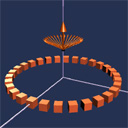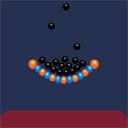Molecules 2D |
Electrostatic Trap |
Charged Ring |
Suspension Bridge
[click the image to see the animation (Shockwave Required)]
In the Shockwave windows, type "I" for instructions.
| 1 |
Molecules 2D
Molecules 2D simulates the interaction of charged particles in a two dimensional plane. The particles interact via the classical Coulomb force, as well as the repulsive quantum-mechanical Pauli force, which acts at close distances (accounting for the "collisions" between them). Additionally, the motion of the particles is damped by a term proportional to their velocity, allowing them to "settle down" into stable (or meta-stable) states.
|

|
| 2 |
The Electrostatic Trap
The Electrostatic Trap simulates the interaction of charged particles in a potential well. The particles interact via the classical Coulomb force, as well as the repulsive quantum-mechanical Pauli force , which acts at close distances (accounting for the "collisions" between them). The potential well is given by a force directed radially inward that is proportional to the distance from the origin. In addition, the motion of the particles is damped by a term proportional to velocity, which allows them to "settle down" into stable and meta-stable states.
|

|
| 3 |
The Charged Ring
This simulation illustrates the electric field generated by a charged ring, and shows how, by the principle of superposition, a continuous charge distribution can be thought of as the sum of many discrete charge elements (in this case, thirty). Each element generates its own field, described by Coulomb's Law (and represented here by the small vectors attached to the observation point), which, when added to the contribution from all the other elements, results in the total field of the ring (given by the large resultant vector, and by the large two dimensional field map). By moving the observation point around with the arrow keys, changes in field magnitude and direction can be observed at different positions relative to the ring.
|

|
| 4 |
The Suspension Bridge
In this simulation, an "electromagnetic suspension bridge" is created by attaching a series of positive and negatively charged particles to two fixed endpoints, and adding a downward gravitational force. The tension in the "bridge" is supplied simply by the Coulomb interaction of its constituent parts and the Pauli force keeping them from collapsing in on each other. Initially, the bridge only sags slightly under the weight of gravity, but what would happen to it under a rain of massive neutral particles? Press "o" to find out!
|

|